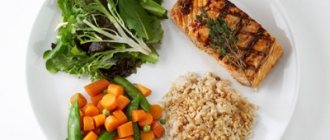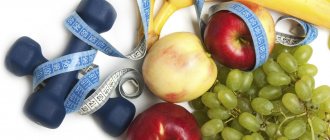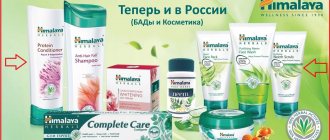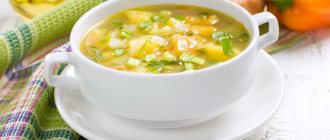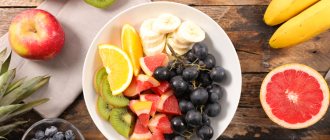Symptoms
It is currently believed that ordinary superficial gastritis does not cause any symptoms. The cause of complaints in this situation is considered to be functional dyspepsia.
However, during the period of exacerbation of chronic gastritis (severe inflammation, formation of erosions), symptoms may appear. Clinical manifestations also occur during a long, long-term course of the disease, when deep atrophy of the mucous membrane of all parts of the stomach occurs. In these cases, the development of both local and general manifestations is possible.
Local disorders:
- dyspepsia (heaviness and feeling of pressure, fullness in the epigastric region, appearing or worsening during meals or shortly after eating, belching, regurgitation, nausea, unpleasant taste in the mouth, burning in the epigastrium)
- with increased secretory function of the stomach, signs of “intestinal” dyspepsia may appear in the form of defecation disorders (constipation, weakness, unstable stools, rumbling, bloating)
- abdominal pain, nausea, vomiting, weight loss, diarrhea develop when consuming certain foods, medications - in patients with (allergic) chronic gastritis
Common disorders:
- weakness, fatigue
- sudden weakness, hiccups, pallor, sweating, drowsiness, unstable stool after eating can occur with atrophic forms of chronic gastritis, when a stage occurs when the cells of the stomach cease to produce enough gastric juice for digestion.
- weakness, increased fatigue, drowsiness; Pain and burning sensations occur in the mouth and tongue: a deficiency of vitamin B12 occurs, which develops with severe atrophy of the gastric mucosa.
To assess your own risk of developing chronic gastritis, take a few minutes to answer the questions below.
- Do you have discomfort in the stomach (epigma)?
- Do you or your relatives have gastrointestinal diseases?
- Is there anyone in your family who has been diagnosed with Helicobacter pylori?
- Do you often visit public eating places?
- Are you bothered by belching air, food or sour things?
- Are you bothered by bloating and/or rumbling in your stomach?
- Have you noticed weight loss?
- Do you often take medications to relieve pain in your head, stomach, abdomen, or other organs of the body?
- Do you often encounter stressful situations?
- Do you smoke?
- Do you drink alcohol?
- Do you have any occupational hazards?
If you answered “YES” to at least 3-4 questions, you are at risk of developing chronic gastritis. In this case, you and your family need to consult a gastroenterologist.
Timely treatment and treatment will reduce the risk of possible complications of gastritis.
Diagnostics
Instrumental studies
- Fibroesophagogastroduodenoscopy (FGDS) is the most informative research method for chronic gastritis; it also helps to identify many other dangerous gastrointestinal diseases, such as GERD. During FGDS, the mucous membrane of the esophagus, stomach and duodenum is completely examined. Only by performing an FGDS can a diagnosis of chronic gastritis be made, as well as a biopsy (a piece of mucous membrane) taken to determine the activity of inflammation, the presence of mucosal atrophy, and the detection of Helicobacter pylori infection.
- Ultrasound of the abdominal cavity. Indirect signs of inflammation of the stomach walls are assessed, and other organs of the gastrointestinal tract are also examined to exclude their pathology, which is common in chronic gastritis.
- Breath test. Allows you to detect the presence of Helicobacter pylori infection. It is more often used to confirm cure for this infection after a course of therapy, as well as in cases where FGDS with a biopsy cannot be performed for some reason.
Laboratory methods
- Clinical, biochemical blood tests, coprogram, stool examination for occult blood.
- Detection of H. Pylori antigens in feces and detection of antibodies to Helicobacter in the blood (also used when FEGDS is impossible or impractical).
- Gastropanel - allows you to identify H. Pylori infection and determine the presence of atrophy of the gastric mucosa.
Important! The scope of the necessary examination can only be determined by a gastroenterologist. If you are in doubt where to start, then you should undergo a basic examination of the stomach, with the results of which you can consult a doctor.
Diagnosis of chronic gastroduodenitis
Diagnosis and treatment of gastroduodenitis is carried out by a gastroenterologist. If this pathology is suspected, the following types of studies are performed:
- Patient interview and physical examination - complaints of discomfort, pain, nausea, belching or heartburn.
- Endoscopic examination. It is performed using a thin endoscope, which is inserted into the stomach through the esophagus. This method is called esophagogastroduodenoscopy. This is an informative study that allows you to identify hypertrophy, atrophy, redness, pallor or thinning of the walls of the stomach and duodenum.
- Endoscopic biopsy. During an endoscopic examination, a small fragment of the mucous membrane is removed. The tissue is then examined under a microscope for the presence of characteristic lesions or atypical cells (to exclude tumor processes).
- Determination of acidity. This is a method of intraventricular pH-metry. The acidity in the body of the stomach and its antrum is measured. The study allows you to establish normal, low or high acidity. This information is extremely important for developing the correct treatment tactics.
- Test for the presence of H. pylori. The pathogen can be identified using a special breath test. PCR is also performed or antibodies to the bacteria are determined.
The patient undergoes a breath test to detect Helicobacter pylori.
Photo: Association of Medicine and Analytics / YouTube Instrumental diagnostics. To visualize the condition of the stomach and intestines, ultrasound (US), radiography, electrogastrography and other research methods are performed.
Important! The manifestations of chronic gastroduodenitis are very similar to the symptoms of other diseases of the digestive system. Therefore, differential diagnosis is important - a series of measures that make it possible to distinguish gastroduodenitis from chronic cholecystitis, pancreatitis, enterocolitis and peptic ulcer.
Treatment
Depending on the clinical situation, the severity of inflammatory and atrophic gastritis, the following is used in treatment:
- proton pump inhibitors (Omeprazole, Rabeprazole, Esomeprazole, etc.)
- H2-histamine receptor blockers (ranitidine, famotidine).
- bismuth preparations
- antacids
- antibacterial drugs
- prokinetics
- preparations of hydrochloric acid and gastric juice enzymes.
All types of drug therapy should be prescribed and monitored by a gastroenterologist.
Considering the presence of clinically and morphologically different forms of chronic gastritis, at the EXPERT Clinic, treatment is selected depending on the etiology, morphology and stage of the disease.
An important principle for us is compliance with the stages of treatment.
First stage
The doctor prescribes therapy:
- mode
- diet
- selection of primary therapy depending on the presence of excess secretion of gastric juice or its insufficiency
- auxiliary medications depending on the activity of mucosal inflammation (antacids, bismuth preparations)
- drugs that improve gastric motility (prokinetics) in the presence of bile reflux into it from the duodenum
- in the presence of Helicobacter pylori infection, antibacterial drugs as necessary
- If iron or folate deficiency anemia is detected in a patient with atrophic gastritis, therapy with vitamin B12 and iron supplements is carried out.
Second phase
Evaluation of the effectiveness of the therapy:
- If, with the use of drugs, the disease activity decreases, the state of health improves, then the diet is expanded, the doses and frequency of taking the drugs are reduced, and a date is set for a return visit to the doctor. If treatment is insufficiently effective, therapy is adjusted.
- If Helicobacter pylori was treated, then a month after the end of the course of therapy, the patient is re-examined for the presence of this infection using a breath test. If the course is completed successfully and the microbe is not detected, the patient’s health is good, then a plan for further preventive visits to the doctor is discussed. If treatment of the infection is unsuccessful, the issue of prescribing standard second-line antibacterial drugs or culturing the bacteria to determine its sensitivity to specific antibiotics is decided.
- After normalization of health and successful treatment of Helicobacter Pylori, the patient continues to be observed by the attending physician; The frequency of preventive visits to the doctor is determined, as well as the frequency of endoscopic and laboratory examinations.
Forecast
The stomach is the initial link of the digestive system, and disruption of its function immediately affects the condition of other digestive organs, causing malfunction of the small and large intestines, pancreas, liver and leading to an increase in the content of pathogenic bacteria in the intestines.
Effective treatment of chronic gastritis allows you to protect other organs of the gastrointestinal tract from the harmful effects of constant inflammation in the stomach.
It must be remembered that long-term superficial Helicobacter pylori gastritis without appropriate treatment ends with atrophy of the gastric mucosa of varying degrees. With chronic atrophic gastritis, there is a potential danger of developing into cancer.
In the chain of these pathogenetic events from chronic gastritis to gastric cancer, Helicobacter pylori plays a primary role.
Therefore, competent treatment of chronic gastritis, successful eradication of Helicobacter pylori infection, followed by careful observation by a gastroenterologist, can reduce the risk of developing stomach cancer to almost zero.
Authorized Products
After several days of a strict diet, the patient slowly switches to a varied menu. During the entire treatment, the patient is recommended to drink still mineral water.
You can eat:
- Baked chicken in the oven or air fryer, as well as steamed.
- You can consume high-quality butter and refined sunflower oil in reasonable quantities.
- You can add low-fat cheese and cottage cheese to your diet.
- Starchy vegetables such as potatoes, carrots, and zucchini are recommended to be steamed, baked, or mashed.
- It is recommended to eat yesterday's black bread or dried loaf.
- For sweets, honey and marshmallows with a mug of warm tea are allowed.
- Vegetable and fruit juices allowed include banana, strawberry and carrot.
- Puree porridges made from rice, buckwheat or semolina are good for the stomach.
- Milk soups with noodles.
If these recommendations are followed, the patient does not feel hungry. The functioning of the digestive system returns to normal, and metabolism improves.
The products that make up the diet are not expensive and accessible.
As for the disadvantages, the taste of dishes without salt and spices deteriorates, and the method of preparing them takes a lot of time.
Prevention and recommendations
To prevent the development of the disease, as well as relapse, it is necessary to adhere to a proper, balanced and regular diet.
Meals should be frequent, 5-6 times a day, food is not hot, carefully processed. It is also recommended to stop smoking tobacco and taking medications that have an adverse effect on the gastric mucosa.
For gastritis with high acidity, diet No. 1 is prescribed, which ensures the absence of chemical or mechanical irritation of the gastric mucosa.
This is a physiologically complete diet. Food is prepared mainly pureed, boiled in water or steamed. Some dishes are baked without a crust. Fish and lean meats can be served in pieces. Flat salt is moderately limited. Very cold and hot dishes are excluded. Diet: 5-6 times a day. Before going to bed, drink milk and cream.
For gastritis with low acidity, diet No. 2 is prescribed, which ensures the absence of mechanical irritation of the gastric mucosa, but helps stimulate its secretory activity.
The diet is physiologically complete. Dishes of varying degrees of grinding and heat treatment are shown - boiled, stewed, baked, fried without forming a rough crust (do not bread them in breadcrumbs or flour); pureed dishes made from foods rich in connective tissue or fiber. Excluded from the diet are foods and dishes that linger in the stomach for a long time, are difficult to digest, irritate the mucous membrane of the gastrointestinal tract, very cold and hot dishes, and spicy seasonings.
More detailed dietary recommendations can be obtained by consulting a nutritionist.
Diet No. 2 - allowed and prohibited foods
The menu for this diet is more varied, and the restrictions are not so voluminous, but still they cannot be ignored.
Authorized products:
- Rice, buckwheat, oatmeal, cooked in vegetable broth or water;
- Boiled durum wheat pasta;
- Soups cooked in weak meat or vegetable broth, seasoned with cereals, noodles, meatballs made from dietary meat;
- Boiled, baked or fried without crust lean lamb, turkey, rabbit, chicken, lean pork;
- Products made from minced lean meat, prepared by boiling;
- Stewed or boiled lean fish;
- Stewed, boiled, baked vegetables that do not contain coarse fiber, salads and vinaigrettes;
- Ripe tomatoes;
- Spicy fresh herbs;
- Eggs, cooked soft-boiled, in the form of a steamed omelet, or in the form of a fried egg without crust;
- Low acidity fruit and berry juices;
- Mineral water with a high content of sodium chloride - Narzan, Kuyalnik, Mirgorodskaya, Minskaya.
Prohibited products:
- Millet, semolina, pearl barley and barley cereals;
- Fresh baked goods;
- Fatty meat and fish;
- Dishes from legumes;
- Mushrooms in any form;
- High fiber vegetables;
- Strong coffee, tea;
- Cocoa and chocolate;
- Mayonnaise and other fatty sauces;
- Pork lard, bacon;
- Smoked meats, canned food.
Acceptable desserts are biscuits, marshmallows, non-sour jam, honey. Wine, vodka, beer, cognac are not allowed.
FAQ
Is it necessary to follow a strict diet for gastroduodenitis?
Early treatment does not require strict adherence to the diet as previously prescribed, but at the very beginning of treatment, to reduce symptoms, it is, of course, advisable to stick to gentle food (not very hot, not spicy, not carbonated drinks, etc.)
Could gastritis not be associated with Helicobacter pylori?
Yes, gastritis can be caused by the negative effects of a number of medications, immune disorders, and the irritating effect of bile during duodenogastric reflux.
Can Helicobacter pylori cause stomach cancer?
The bacterium itself does not cause oncological processes, but long-term inflammation maintained by it can change the structure of cells - metaplasia, the high degree of which can give impetus to the formation of malignant cells.
Is it possible to cure Helicobacteriosis?
Yes, there are international standards for so-called HP eradication therapy.
Is it possible to become infected again with Helicobacter pylori after treatment?
Yes, it is possible, since lasting immunity is not developed after treatment, but if basic anti-epidemic measures are followed, the risk is minimal.
Menu for the week
We present to your attention a sample menu for a week of diet for gastroduodenitis:
Monday
- Breakfast: 200 g of rice porridge;
- Lunch: vegetable soup with herbs;
- Dinner: buckwheat porridge and low-fat fish cutlet.
Tuesday
- oatmeal with dried fruits, a glass of goat milk;
- 200 g baked chicken meat and kefir;
- cabbage soup and carrot juice.
Wednesday
“Space diet” by Sergei Sivokho: without denying himself anything, the comedian lost 42 kg in 3 months
- 150 g low-fat cottage cheese and a cup of herbal tea;
- buckwheat soup with low-fat meatballs;
- stewed vegetables - 250 g.
Thursday
- semolina porridge with honey or jam, unsweetened black tea;
- steamed chicken cutlets with herbs and low-fat sour cream;
- 200 g boiled rice, apple compote.
Friday
- fruit smoothie;
- mashed potatoes combined with low-fat chicken cutlet;
- stewed cabbage with potatoes and zucchini, a glass of low-fat kefir.
Saturday
- oatmeal, tea with lemon;
- buckwheat, 150 g of boiled rabbit meat and a glass of apple juice;
- baked perch with vegetables.
Sunday
- steamed omelette with tomatoes and herbs, fresh orange juice;
- stewed zucchini, apple and carrot puree;
- wash down the fruit salad with rosehip decoction.
As a snack in a diet for gastroduodenitis, foods such as baked apple, jelly, berry mousse, and 200 ml of low-fat kefir are acceptable.
Recipes
Diet recipes for gastroduodenitis are varied and very easy to prepare. Let's look at the most useful of them:
Light dessert for a diet with gastroduodenitis: Curd cream for the treatment of gastroduodenitis
Curd cream
Ingredients: chicken egg, a tablespoon of sugar and butter, two tablespoons of low-fat sour cream, vanillin.
- beat the egg with sugar;
- then heat over low heat, stirring constantly;
- after 5 minutes, remove from heat and mix with butter;
- then mix with vanilla and sour cream;
- add the egg-sugar mixture to the resulting cottage cheese and beat.
A recipe for an unusual soup on the diet menu for gastroduodenitis:
Semolina milk soup for the treatment of gastroduodenitis
Semolina milk soup
Ingredients: a tablespoon of semolina, 150 ml of milk, a teaspoon of butter and sugar.
- bring milk to a boil;
- carefully sift the cereal;
- then pour the cereal into the milk;
- cook for 25 minutes, stirring constantly;
- then add sugar and butter.
Perhaps the simplest diet recipe for the treatment of gastroduodenitis: Lazy dumplings for the treatment of gastroduodenitis
Lazy dumplings
Ingredients: 400 g low-fat cottage cheese, a tablespoon of flour, a teaspoon of sugar, a tablespoon of sour cream, a chicken egg.
- rub the cottage cheese through a sieve;
- then add all the remaining ingredients to it and mix thoroughly;
- form a small sausage from the resulting mass;
- then cut it into pieces and throw it into boiling water;
- cook for 5-10 minutes;
- eat with sour cream.
The following is a recipe that is recommended to be used 2-3 times while following the above diet to cure gastroduodenitis:
Berry mousse for the treatment of gastroduodenitis
Berry mousse
Ingredients: 200 g of your favorite berries, a tablespoon of semolina, 50 ml of water and a tablespoon of sugar.
- squeeze the berries, strain and boil;
- then add semolina with sugar and put on low heat;
- when the cereal is completely ready, remove the mass from the heat and beat in a mixer;
- then add berry juice.
Recipe that can be used daily in a diet for the treatment of gastroduodenitis:
Steam omelet for the treatment of gastroduodenitis
Steam omelette
Ingredients: a glass of water, 5 chicken eggs, a teaspoon of olive oil and a pinch of salt.
- grease the omelette vessel with olive oil;
- add water and put on low heat;
- beat the eggs with a whisk, adding a pinch of salt;
- pour the resulting mixture into a bowl;
- cover with a lid and cook for half an hour.
Treatment stories
Story No. 1
Patient G., 23 years old, came to the EXPERT Clinic in 2010 with complaints of aching pain 1.5 hours after eating and at night, which went away after eating. When studying the anamnesis, it turned out that the patient’s diet is irregular, often fast food, the young man is fond of tourism, where meals are often carried out in unsanitary conditions. In addition, it was found out that the patient’s father has duodenal ulcer. According to the results of an FGDS with a test for Helicobacter pylori, gastroduodenitis was established with the formation of erosions, a high degree of activity of the inflammatory process and a high contamination of Helicobacter pylori, which was the cause of the development of the disease. It was recommended that all adult family members be tested for Helicobacter, the father’s previous treatment was clarified, and, based on all the medical and life history data obtained, treatment was prescribed for all infected relatives. Against the background of complex antibacterial eradication therapy, health was monitored. A few days after the start of therapy, the patient noted the cessation of pain and improvement in general condition. 2 months after treatment, the patient underwent an FGDS with a test for Helicobacter Pylori. Positive dynamics were obtained with the absence of inflammatory changes in the mucous membrane of the stomach and duodenum; the Helicobacter pylori bacterium was not detected. Over the next 5 years of observation, the patient makes no complaints and once every 6 months carries out a control FGDS with a helic test, and continues to be monitored by a supervisor.
Story No. 2
Patient E., 40 years old, came to the EXPERT Clinic with complaints of pain in the projection of the stomach that occurred immediately after eating and went away with fasting. From the medical history it is known that the patient eats irregularly and has recently had many stressful situations. After a comprehensive examination in the Clinic, including FGDS with a test for Helicobacter and histological examination of the gastric mucosa, a diagnosis was made: chronic gastritis of a high degree of activity, the HP test was negative. The patient was recommended to eat regularly, excluding spicy foods, extractive substances, and carbonated drinks, and was treated with proton pump inhibitors to suppress the production of hydrochloric acid. With changes in diet and treatment, the patient’s well-being improved and the pain stopped. During the control FGDS, minimal inflammation of the gastric mucosa remained. The patient continues treatment and observation with a supervisor.


